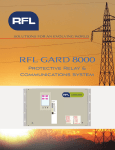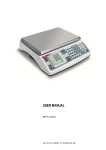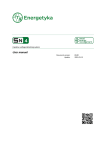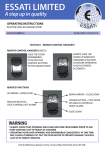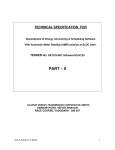Download ROTAX Plus POLE SCAFFOLDING – ASSEMBLY MANUAL
Transcript
ROTAX Plus POLE SCAFFOLDING – ASSEMBLY MANUAL 1. Technical overview, general rules of scaffolding assembly and use 1.1 Scaffolding overview……………………………………………………… 1.2 Norms and regulations regarding scaffolding………………………….. 1.3 General rules of scaffolding assembly………………………………….. Page 2 2 3 2. Scaffolding 1 2.1 Basic elements assembly (partial examples)…………………………... 2.1.1. ROTAX Plus node………………………………………………… 2.1.2. Assemby hints for safer use……………………………………... 2.1.2.1 Safety kit…………………………………………………... 2.1.3. Main elements……………………………………………………... 2.1.4. Platform assembly………………………………………………… 2.1.5. Side protections..………………………………………………….. 2.1.6. Corner assembly………………………………………………….. 2.1.7. Expansion brackets……………………………………………….. 2.1.8. Anchors…………………………………………………………….. 2.1.9. Span beams – gate crossings……………………………………. 2.1.10. Pathways beneath scaffoldings………………………………….. 2.1.11. Scaffolding entrances…………………………………………….. 2.1.12. Scaffoldings near eaves………………………………………….. 2.1.13. Openings and scaffolding adjustment…………………………… 2.1.14. Stand spacing change…………………………………………….. 2.1.15. Additional elements……………………………………………….. 2.2 Scaffolding assembly in facade set-up…………………………………… 4 4 4 5 6 6 7 8 8 9 9 10 11 11 12 12 12 13 2.3 Tower scaffolding…………………………………………………………… 16 2.4 Load-bearing scaffolding…………………………………………………… 19 2.5 Scaffolding for round objects……………………………………………… 20 2.6 Hanging scaffolding………………………………………………………… 20 2.7 Mobile scaffolding…………………………………………………………… 21 2.8 External staircases………………………………………………………….. 23 2.9 Vertical transportation of materials………………………………………... 24 2.10 Assembly scemes for typical scaffoldings in facade set-up……………... 24 3. General requirements and safety rules during scaffolding assembly and use 27 4. Product marking system 32 5. Index of ROTAX pole scaffolding elements 33 1.1. Scaffolding overview ROTAX system scaffoldings are built on a construction grid 3.07 m, 2.57 m, 2.07 m, 1.57 m long and 0.73 m and 1.09 m wide – there is a possibility to expand the grid in all directions. In vertical plane the system's elements can be displaced every 0.5 m. ROTAX scaffolding allows fast and secure realization of spatial structures with complicated shapes. It also allows building large scale platforms, e.g. stages, elevated work platforms, etc. This type of scaffolding can be used as a support or load-bearing structure for different kinds of billboards, stands, camera stations and occasional tribunes placed during cultural and recreational events. 2 2 The permissible load of a scaffolding in facade set-up equals 2 kN/m for scaffolding width of 0.73 m and 3 kN/m for scaffolding width of 1.09 m. 2 2 Scaffolding construction requires the use of steel, working platforms with permissible load of 3 kN/m to 6 kN/m depending on the length of the platform and it's configuration as well as aluminium-plywood and wooden platforms 2 with permissible load of 2 kN/m . Depending on the needs, ROTAX system can use platforms with two kinds of catches: cross-bar catch – round (transom), O-type, cross-bar catch – U-profile U-type (transom). Entire scaffolding assembly system is based on the possibilities given by the specific construction node, which allows the connection of cross-bars, stringers, horizontal and vertical braces. WARNING: WARNING: Criterion no. K/0812-721/1/08 of Institute of Mechanised Construction and Rock Mining - Warsaw (Instytut Mechanizacji Budownictwa i Górnictwa Skalnego w Warszawie) differentiates the concept of a board (single lement) and a platform (build of boards). In this manual, according to the apprenticeship, the word PLATFORM will be used in both meanings. 1.2. Norms and regulations regarding scaffoldings During the design, assembly, disassembly and general use of the scaffoldings, it is crucial to respect all the norms and regulations mentioned in: This manual. Regulation of the Minister of Labour and Social Policy of 28 August 2003 establishing general rules for occupational safety and health – consolidated text (Journal of Laws No. 169/03, item 1650), as amended. Regulation of the Minister of Economy of 30 October 2002 regarding minimal requirements for occupational safety and health as far as the use of machines by workers during working hours (Journal of Laws, No. 191/02, item 1596), as amended. Regulation of the Minister of Infrastructure of 6 February 2003 regarding occupational safety and health during construction works (Journal of Laws No. 47/03, item 401). PN-M-47900-1:1996 "Steel, standing working scaffoldings. Definitions, division and main parameters". PN-M-47900-2:1996 "Steel, standing working scaffoldings. Pole scaffolding made of pipes". PN-M-47900-3:1996 "Steel, standing working scaffoldings. Frame scaffoldings". PN-EN 12811-1:2004 "Provisional structures used at a construction site. Scaffoldings. Conditions for the production and general design rules". PN-EN 12810-1:2004 "Facade scaffolding made of prefabricated elements. Technical specifications of the products". PN-EN 12810-2:2004 "Facade scaffolding made of prefabricated elements. Particular design and construction methods". PN-EN 74:2002 "Couplings, centring plungers and foot sets used in working and load-bearing scaffoldings made of steel pipes. Requirements and examination procedures". PN-EN 39:2003 "Steel pipes for scaffolding construction – Technical regulations for the delivery process”. 2 ROTAX Plus POLE SCAFFOLDING – ASSEMBLY MANUAL 1.3. General rules of scaffolding assembly 1.3.1. Before commencing the assembly, the scaffolding ground base needs to be checked. It has to absorb the loads coming from the weight and vertical forces present on the scaffolding. Load-bearing capability of the ground base, on which the scaffolding has been placed, cannot be lower than 10 MPa. Load-bearing capability is established according to PN-81/B-03020. In case of construction bases and base reinforcement, the scaffolding placement should meet the requirements of PN-M-47900-2 section 4.4. 1.3.2. The proper placement of the scaffolding main level requires the use of plumbing jig and 500 g hammer that is used for wedging together separate elements. 1.3.3. Screw footing should be placed on wooden base perpendicular to the wall. At least two footings should be placed on a single wooden base. Threaded plunger in the frame has to inter-operate with a stand's pipe at minimum length of 150 mm. 1.3.4. Install the primary elements on the screw footings. The units of footings and primary elements should be connected with transoms. The transoms act here as stringers and cross-beams. 1.3.5. During assembly, use only fully-fledged elements of scaffolding. Element's evaluation criteria Elements with visible signs of damage cannot be used. It is particularly important not to use: – elements with signs of corrosion localized at the connection areas (welds), – load-bearing stands with visible damages in the form of pipe twists, section deformation, – steel planks with damaged sheathing or damaged and bended catches, – aluminium-plywood platforms with visible damages of plywood sheathing in the form of stratification, cracks, bulges, decrements as well as bended load-bearing platform beams, – screw footings with damaged threads, twisted plungers or resistive nuts. Damaged elements should be replaced with the ones in working order. The elements that can be repaired should be handed back for reparation. Element straightening is permissible only when there are no deformations to circular section. It is forbidden to perform repairs on load-bearing elements e.g., stands, braces and footings. 1.3.6. The scaffolding should be placed in such a way that the spacing between the scaffolding and building's facade would not exceed 0.2 m. In case of wider spacing, additional mid and lower railings should be attached on it's internal side, as well as longitudinal curbs that protect the working platform. 1.3.7. Wall scaffolding brace is performed on the external surface of the scaffolding, parallel to the wall's face. The process consists of large-format and tower bracing. Vertical braces should be placed in every fifth bay of the scaffolding net screen, for the bay of 2.57 m, and every fourth for the bay of 3.07 m. At least two braces should be placed counter wise on a single level. Longitudinal transoms should be placed in braced bays. They will act as vertical braces. Spacing between braces should not exceed 10 m. 1.3.8. Stands' bottom opening plates should be buckled crosswise with transoms. Additionally, transverse transom should be attached in a way that the spacing between the transom buckling the primary element and the stand's bottom transom does not exceed 0.5 m. 1.3.9. Extreme ends of the platforms should be secured with transverse transoms. This prevents entering bays without installed platforms. 1.3.10. In the bay where circulation path will be installed, U-transoms ought to be mounted, as well as platforms for vertical communication. 3 WARNING! 4 ROTAX Plus POLE SCAFFOLDING – ASSEMBLY MANUAL During scaffolding assembly, personal safety cord must be attached to the facade side of the scaffolding elements. Cord and transom binding must be performed to the transoms that are higher than the level you are standing on. It is also applicable to anchoring plates. When the stands of the assembled level are not bound together, mount the safety cords to the plates at the height of 1 m. It is allowable to attach the cord to the elements of the level you are standing on, but only when there is no other possibility. There are also ways to attach personal protective equipment directly to the structure surrounded by the scaffolding. The way of realization is individual to the structure. 2.1.2.1. Safety Kit Assembly Safety Kit is a temporal safety precaution for the fitter. It is used during entry to the next level, before posts and transoms are installed. The kit consists of 2 assembly posts and telescopic railing. After the Safety Kit has been installed, the railing can be found one meter above the platform, over the tier where the post is attached. The post can be mounted and dismounted from the level of both tiers. Owing to the telescopic railing, it is possible to relocate the posts onto subsequent levels (without the need of dismounting the railings) and adjust the length of the set in the range of: 1.5 m up to 2.07 m – short version or 2.07 m up to 3.7 m – long version. The lightness of the structure makes the set relocation to the next scaffolding level (after the work is finished on the previous level) easy for the fitters. Assembly stages: 1 Assembly post consists of two pipes that can be rotated and moved against joint axis. This allows the catch opening and closing. During proper installation of the post, the bolt in the bottom catch enters the opening in the closing metal plate (Fig. 2.6a). 2 Mount the post on the stand by lifting and rotating the external pipe, so the bottom catch leans on the upper railing of the scaffolding (transom) (Fig. 2.6b). 3 Mount the telescopic railing in the eye of the post. 4 Mount the other end of the telescopic railing in the eye of the post not yet mounted. 5 Mount the second post in the same manner as the first (section 2) on the other end of the scaffolding bay. 6 After stands and transoms has been mounted on the upper level of the scaffolding, the Safety Kit can be relocated onto subsequent level by opening the railing post's catches and closing them on the higher level. Telescopic railing does not need to be dismounted during this procedure. WARNING! 5 6 ROTAX Plus POLE SCAFFOLDING – ASSEMBLY MANUAL Platform assembly with O-transom 2.1.5. Side protections According to norm requirements, every working and safety platform has to have complete safety measures. Platforms with complete safety measures include main and pass-by railings as well as curbs. 7 WARNING! 8 9 ROTAX Plus POLE SCAFFOLDING – ASSEMBLY MANUAL 2.1.10. Pathways beneath scaffoldings Performing construction/repair works along public sidewalks often requires constructing secured passageways for pedestrians. An example of secured passageway is presented in the illustration below. Double U-transom Fill with system platforms or planks covered with shock-absorption material that protects against falling objects Protective roof bracket Pipe connector Vertical standard 2.5 m Collar base starter Steel footing Fig. 2.1 – Passageway set-up with the use of scaffolding base expansion and roof bracket WARNING! Assembly manual does not substitute OHS rules at the construction site! Construction manager is responsible for proper scaffolding assembly and inspection! 10 11 12 13 ROTAX Plus POLE SCAFFOLDING – ASSEMBLY MANUAL 2.2.4. On the newly prepared basic level stands with proper length are applied. Use basic lengths of the stands, e.g. 2 m or 4 m. In such case, set them up alternatingly: 2 m stand should neighbour 4 m stand. 2.2.5. At the height of 2 m, measuring from primary element, mount cross-bars, stringers and platforms of circulation path. When assembling higher levels, mount assembly planks as additional platforms. When the scaffolding is low, mount standard platforms. Please remember that, according to the needs, platforms can be attached with pipe-type transom (∅ 48 mm) or U-type transom. Each platform should be secured (see Fig. 9 section 2.1.4). bays, where system working platforms are not mounted, should be braced with horizontal brace, in the bays with vertical braces. 2.2.6. At the height of second platform anchor the scaffolding to the facade with wall ties, normal couplings and anchor eye-bolts. In certain areas of construction grid vertical braces must be mounted. Single level should contain at least two braces. After anchoring the scaffolding, curbs must be mounted on working and safety platforms. It is crucial during assembly to mount horizontal brace in the bays where vertical brace is mounted, but there is no platform. WARNING: Anchoring must be performed concurrently with scaffolding assembly. ual does not substitute OHS rules at the construction site! Construction manager is responsible for proper scaffolding assembly and inspection! 14 15 ROTAX Plus POLE SCAFFOLDING – ASSEMBLY MANUAL During stands' assembly, secure the stands from detaching by shifting the safety cotter (pin). Corner connections for stands need to be secured with elastic pin due to collision of the safety cotter with a transverse curb. Avoid connecting the stands outside scaffolding nodes. Working and safety platform has to be secured with curbs and two stringers (horizontal O-transoms) that also act as protective railings. 2.2.9. If the bay requires broadening then it can be achieved by mounting steel, 0.36 m high bracket at the internal side of the scaffolding (facade set-up) as well as 0.73 m and 0.36 m high steel bracket at the external side of the scaffolding (facade set-up), as shown in the illustrations in section 2.1.7. Scaffolding broadening from external side is only permissible on one level for entire height of the scaffolding. When the gap between platforms exceeds 25 mm, install the filling made of planks. When the gap between platforms exceeds 80 mm, install horizontal transom or filling made of planks. 2.2.10. Working platform can be lined with wooden beams according to the scheme in section 2.1.15. In such case, follow the data on geometry and span of the wooden beam, as presented in mentioned section. 2.2.11. In order to secure the works on the roof, install 2 m high stands and 4 O-transoms on the highest scaffolding level. These will protect the elements rolling down from the roof from falling outside the scaffolding– see section 2.1.12 2.3. Tower scaffolding This type of scaffolding is commonly used as a supervision scaffolding, or is utilized for simple installation works. It is also used as a support structure for camera station or as a load-bearing structure for speaker sets during events. Scaffolding equipped with castors can act as a mobile scaffolding (rolling). Before assembly, make sure that the ground base's load capability is sufficient. 16 1 2 3 Place steel footings accordingly to the desired size. Underlay every foot with wooden pad in order to distribute the scaffolding load onto the ground base. Install the primary elements on each foot. WARNING! Assembly manual does not substitute OHS rules at the construction site! Construction manager is responsible for prop er scassembly an 17 18 d inspection! 19 20 21 22 23 24 25 26 27 28 ROTAX Plus POLE SCAFFOLDING – ASSEMBLY MANUAL 3. General requirements and safety rules during scaffolding assembly and use 3.1. All the workers hired for scaffolding assembly and disassembly should be trained for specific scaffolding assembly and be authorized by training centres approved by Instytut Mechanizacji Budownictwa i Górnictwa Skalnego w Warszawie (Institute of Mechanised Construction and Rock Mining - Warsaw). During assembly and disassembly of scaffolding, danger zone must be established and secured with proper markings and railings placed at the minimum height of 1.5 m. Danger zone cannot be smaller than 1/10 of scaffolding height, and not less than 6 m. Assembly and disassembly of scaffolding is forbidden: a) after sunset, if no proper lighting has been provided; b) during heavy fog, rain, snow and sleet; c) during storm and wind that exceeds 10 m/s. It is forbidden to place scaffoldings near overhead power lines, if the scaffolding radial distance from closest power line wires is less than: a) 3 m for a power line with maximum rated voltage of 1 kV; b) 5 m for a power line with rated voltage between 1 kV and 15 kV; c) 10 m for a power line with rated voltage between 15 kV and 30 kV; d) 15 m for a power line with rated voltage between 30 kV and 110 kV; e) 30 m for a power line with rated voltage above 110 kV. During assembly and disassembly of scaffoldings underneath overhead power lines or in closer distance than mentioned above, it is necessary to shut the power down. Scaffolding lightning rods Scaffolding structure should be equipped with lightning rods according to PN-M-47900-2:1996 "Standing, steel made, working scaffoldings. Pole scaffolding made of pipes", section 4.8. "Scaffolding lightning rods". 3.3. The use of scaffolding is permissible only after scaffolding commissioning substantiated with a signature in construction logbook or with commission report, accordingly to regulations. 3.4. Scaffolding load-bearing capabilities must be placed on information board attached to scaffolding. Loading the scaffolding with materials above its load-bearing capabilities as well as worker gatherings on platforms is forbidden. 3.5. Scaffolding can be equipped with material transportation tool with outriggers attached to scaffolding structure. Outriggers can be made of pipes attached to scaffolding with couplings. A standard, factory delivered block (e552100) can also be used. Maximum weight of lifted materials cannot exceed 150 kg. When using scaffolding attached hoists with larger load capacities, static proof calculations must be performed for the scaffolding. Transport outrigger must be additionally anchored in at least two places. The spacing between outriggers must not exceed 30 m. The distance from collective axis to the furthest point of scaffolding (in lifting plane) should not exceed 0.5 m. The height from block's point of attachment to the level of the platform cannot be smaller than 1.6 m. For vertical transport it is advisable to use winches adapted for scaffoldings, e.g. winches made by GEDA. The device must have UDT (Office of Technical Inspection) commissioning certificate. Winch assembly must be performed only 29 as directed by user manual. 3.6. Each scaffolding must be equipped with circulation paths. Circulation paths must be made simultaneously with scaffolding assembly. The spacing between circulation paths cannot exceed 40 m. The distance from circulation path to furthest work place cannot exceed 20 m. Circulation paths are made inside the scaffolding by mounting aluminium platforms with entry hatch, aluminium ladder and steel planks with entry hatch. 3.7. Scaffolding can be placed in wind zone I and II according to PN-77/B-02011, as illustrated on the map. Scaffoldings made to be used in wind zone IIa, IIband III must undergo additional analyses with static proof calculations for the wind. RNI N Assembly manual does not substitute OHS rules at the construction site! Construction manager is responsible for proper scaffolding assembly and inspection! ROTAX Plus POLE SCAFFOLDING – ASSEMBLY MANUAL 3.8. All scaffolding pipe elements' connections must be made with standard and rotary coupling. Rotary and normal coupling must be screwed with a screw tightening torque of 50 Nm. 3.9. Scaffolding must be placed on hardened basis. Otherwise, use wooden pads (one pad for two footings). 3.10. Scaffolding disassembly can be performed after all the construction works (performed from the scaffolding) are 30 finished and all working platforms, tools and materials are removed. Partial disassembly of the upper part (along work progress) is allowable. It is forbidden during disassembly to cast down elements from heights. After disassembly, all elements should be cleaned, checked and segregated if some need to be fixed or replaced. 3.11. Each scaffolding, after assembly and before its use, must undergo operational tests. The tests should be performed each time the assembly works are completed according to PN-M-47900-2:1996 "Standing, steel made, working scaffoldings. Pole scaffolding made of pipes", section 7.3. „Assembled scaffolding test at the user's site”. The test must be concluded with a report. 3.12. During its use, the scaffolding undergoes the following inspections: a) everyday inspection performed by scaffolding foreman; b) decade inspections (every 10 days) performed by scaffolding maintenance technician or engineering/technical worker; c) ad hoc inspections performed by the commission including construction manager, certified construction professional and a foreman. Ad hoc inspections are inspections performed after heavy rains, lightning strikes, strong winds, ground tremors, etc. (environmental phenomena). During inspection the following must be checked: – condition of security measures (railings, curbs), – condition of platforms (gaps between platforms, damages, loads on the platforms), circulation paths (ladder attachment, entry latch performance), – condition of winches and supportive structure, – security measures against falling of the upper platforms and platforms installed on brackets, – condition of rotary couplings, – condition of scaffolding ground base, – anchoring strength, – condition of lightning rods. Inspection results must be logged in construction logbook. for proper scaffolding assembly and inspection! ROTAX Plus POLE SCAFFOLDING – ASSEMBLY MANUAL 31 3.13. Steel planks must be assembled in a way that the gap between two elements of the scaffolding would not exceed 25 mm. When assembling working platform's expansion brackets, longitudinal transom must be mounted at the height of platforms in order to fill the gap. It may also be filled with wooden planks. 3.14. It is allowable to expand scaffolding platforms with cross-bars (transoms) and stands supported by vertical braces. Platform expansion can be performed on external side of the scaffolding, on its last level, or on any level with obligatory anchoring of the extension to the wall and to one level above and below. 3.15. When placing loads on the scaffolding platforms, the following hints and rules must be obeyed: a) actual working weight on the platform consist of total value of individual weights on different spaces. Thus, it is important to avoid accumulating loads in one area of the scaffolding; b) platform load must be placed evenly on its entire surface; c) each worker is an equivalent of 0.8 kN (80 kg); d) when there is an element with certain weight being delivered with a hoist onto scaffolding, then the weight of the element needed for platform load calculation must be increased with modulus 1.2; e) avoid dynamic loads on the platform, e.g. jumping, throwing weights, etc.; f) platforms mounted on brackets must be in the same load group as standard scaffolding platforms. 3.16. Every scaffolding structure has to have at least two platforms: Working platform and safety platform placed directly on the level below according to PN-M-47900-2:1996. 3.17. The rules for scaffoldings, measuring max height of H= 34 m, introduced in this manual regard to the scaffoldings which length does not exceed 10 m. The scaffolding longer than 10 m must be treated as non-standard scaffolding, which requires individual design. 3.18. Net screens and canvases are used to protect workers from objects falling down from scaffolding. 3.19. Scaffolding placed adjacent to the public road must be equipped with protective canopy recognized by Regulation of the Minister of Infrastructure of 6 February 2003 regarding occupational safety and health during construction works (Journal of Laws No. 47, item 401). 3.20. Stands placed near gates, clearances and crossings with car traffic, must be secured with roll-stops not connected to scaffolding structure. 3.21. The area, where assembly and disassembly works takes place, must be marked with visibly placed information boards mounted at the height of 2.5 m measuring from the ground level. Signs on the boards must be visible from a distance of at least 10 m. 3.22. If a crossing was rendered inactive during scaffolding assembly (with proper permission from territorial authority), a barrier must be placed at the crossing and a red information board with a warning sign about the crossing being inactive. Red light must be placed at the barrier during night. 3.23. Information board about working platform's permissible load must be placed on scaffolding visible spot. 3.24. When using scaffolding during winter, or during heavy snow – remove the snow from scaffolding before proceeding with work. 3.25. Scaffolding storage and transport must comply with the provisions of PN-M-47900-2:1996 "Standing, steel made, working scaffoldings. Pole scaffolding made of pipes". 3.26. Use only genuine, undamaged system parts during assembly. 3.27. Permissible offset for estimated anchoring places equals 0.2 m. When there is a need to anchor the scaffolding further away from scaffolding node, make individual design for the scaffolding. WARNING: Maximum bay length for facade set-up scaffolding equals L = 3.07 m. This kind of bay requires the use of steel or aluminium platforms. The OHS general rules specific for this branch must be obeyed during scaffolding work. WARNING! Assembly manual does not substitute OHS rules at the construction site! Construction manager is responsible for 32 proper scaffolding assembly and inspection! 5. Index of ROTAX pole scaffolding elements 33 34 35 36 37 38 39 ROTAX Plus POLE SCAFFOLDING – ASSEMBLY MANUAL SCAFFOLDING COMMISSION PROTOCOL 1 Protocol reg. no. ....................................................................................................................................................... 2 Scaffolding acceptance date .................................................................................................................................... 3 Scaffolding assembly contractor .............................................................................................................................. ............ tel. .......................................................................... 4 Scaffolding user (Assembly ordering party) .............................................................................................................. 5. Scaffolding's technical overview: – type/model – scaffolding parameters ........................................................................................................................................ – place of assembly ................................................................................................................................................ – working platforms' permissible load .................................................................................................................... – special equipment ................................................................................................................................................ – ground's resistance (grounding) ........................................................................................................................... – dates for subsequent scaffolding inspections ...................................................................................................... – scaffolding appropriation ...................................................................................................................................... DECLARATION AND CONFIRMATION 1 Assembly contractor certifies that the scaffolding described in this protocol is complete. The scaffolding was assembled with accordance to the rules of building and assembly manual provided by the manufacturer, as well as to the rules of OHS. The assembly was performed by certified fitters. 7. With this protocol, the Assembly contractor delivers as follows: a) scaffolding scheme b) scaffolding assembly manual c) ................................................................................................. d) ................................................................................................. Scaffolding user accepts the scaffolding for exploitation without reservation and declares that is aware of 40 2 the rules of use resulting from the assembly manual instructions. Commission composed of below mentioned confirms the scaffolding hand-over after assembly and commission to use. Commission members: a) ............................... ................................ ................................ – User b) ............................... ................................ ................................ – User c) ............................... ................................ ................................ – Contractor Name position signature Application date for scaffolding disassembly:............................................................ Changes in the scaffolding structure can only be performed by Assembly contractor. Check scaffolding's technical condition and completeness during its use. 41









































